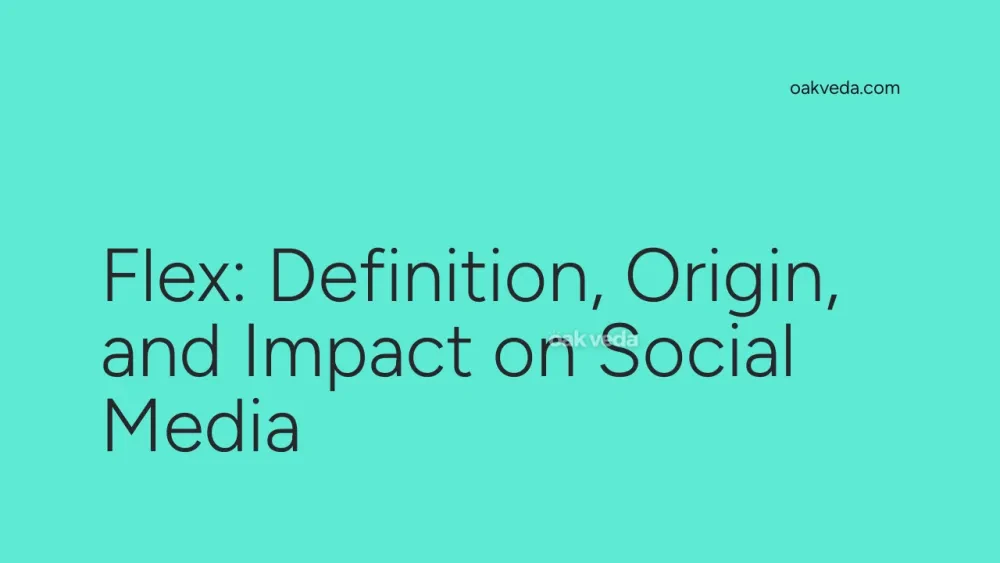
What is Flex?
In the realm of social media, "flex" has evolved into a powerful term that goes beyond its literal meaning. When someone "flexes" online, they're essentially showcasing or boasting about their achievements, possessions, skills, or attributes. It's a digital display of confidence, success, or superiority in a particular area, aimed at garnering recognition, admiration, or validation from their audience.
Origin and Development of Flex
The term "flex" has its roots in African American Vernacular English (AAVE), where it originally emerged as a way to describe showing off or bragging. In AAVE, "flexing" signified the act of flaunting one's accomplishments, skills, or material possessions to assert status or dominance within a social group.
Over time, "flex" transcended its AAVE origins and gained widespread usage in mainstream culture, particularly on social media platforms. Its meaning expanded to encompass various forms of self-promotion, not limited to material possessions but also including achievements, talents, experiences, and lifestyle choices.
How Flex Works on Social Media
On social media platforms, flexing can take various forms:
-
Material Possessions: Users may post pictures or videos showcasing luxury items, expensive purchases, designer clothing, or high-end gadgets to highlight their wealth or access to exclusive products.
-
Accomplishments and Experiences: Individuals might share photos or stories about their achievements, such as awards, academic success, career milestones, travel experiences, or noteworthy events.
-
Skills and Talents: Flexing can involve demonstrating exceptional abilities or expertise in areas like sports, arts, music, cooking, or any other field where an individual excels.
The key to a successful flex on social media often lies in the presentation. Users carefully curate their content, using high-quality images, clever captions, and strategic hashtags to maximize the impact of their flex.
Types of Flexes on Social Media
While flexing can encompass a wide range of topics, some common categories have emerged:
- Wealth Flex: Showcasing expensive purchases, luxury vacations, or high-end lifestyle choices.
- Fitness Flex: Displaying physical transformations, workout achievements, or athletic accomplishments.
- Intellectual Flex: Sharing academic achievements, professional certifications, or intellectual pursuits.
- Relationship Flex: Highlighting romantic relationships, friendships, or social connections with influential people.
- Lifestyle Flex: Showcasing unique experiences, exclusive events, or enviable daily routines.
Popular Examples of Flexing
Celebrities and influencers often lead the way in flexing on social media. For instance:
- Kylie Jenner's posts of her luxury car collection
- Dwayne "The Rock" Johnson sharing his intense workout routines
- Travel influencers showcasing exotic destinations and first-class flights
- Tech entrepreneurs displaying their latest gadgets or startup successes
However, flexing isn't limited to the rich and famous. Everyday users also engage in flexing, sharing their personal achievements, from getting a new job to completing a DIY project.
Impact of Flexing on Social Media Culture
Flexing has significantly influenced social media culture, shaping user behavior and content creation:
-
Aspirational Content: Flexing often creates aspirational content that can inspire and motivate others to pursue their goals.
-
Comparison Culture: The prevalence of flexing can lead to increased social comparison, potentially affecting users' self-esteem and mental health.
-
Authenticity Debates: The rise of flexing has sparked discussions about authenticity on social media and the pressure to present a perfect life online.
-
Influencer Marketing: Brands have capitalized on the flexing trend, partnering with influencers to showcase products in a way that feels like organic flexing.
Controversies Surrounding Flexing
While flexing can be a form of self-expression and celebration, it's not without controversy:
- Promoting Materialism: Critics argue that excessive flexing of material possessions promotes a culture of consumerism and superficiality.
- Mental Health Concerns: The constant exposure to others' highlight reels can lead to feelings of inadequacy and anxiety among social media users.
- Authenticity Issues: Some flexes may be exaggerated or entirely fabricated, raising questions about honesty and transparency on social media.
- Socioeconomic Disparities: Flexing can highlight and potentially exacerbate existing socioeconomic inequalities.
How Brands and Influencers Use Flexing
Savvy brands and influencers have incorporated flexing into their marketing strategies:
- Product Placement: Influencers subtly (or not so subtly) flex products as part of their lifestyle content.
- User-Generated Content: Brands encourage customers to flex their products, creating authentic promotional content.
- Aspirational Marketing: Luxury brands use flexing to create desire and exclusivity around their products.
Future Trends Related to Flexing
As social media continues to evolve, so too will the concept of flexing:
- Authenticity Movement: There's a growing trend towards more authentic, less curated content, which may influence how people flex online.
- Virtual and Augmented Reality: As these technologies advance, we may see new forms of digital flexing in virtual spaces.
- Sustainability Focus: With increasing awareness of environmental issues, eco-friendly or sustainable flexing may gain popularity.
FAQs about Flexing
-
Is flexing always negative? No, flexing can be positive when it's used to celebrate genuine achievements or inspire others. However, excessive or inauthentic flexing can be perceived negatively.
-
How can I flex positively on social media? Focus on sharing genuine accomplishments, express gratitude, and use your flex to inspire or help others rather than simply boasting.
-
Can flexing affect mental health? Yes, constant exposure to others' flexing can lead to feelings of inadequacy or FOMO (fear of missing out). It's important to consume social media mindfully and remember that most people only share their highlights.
In conclusion, "flex" has become a significant part of social media culture, influencing how users present themselves and interact online. While it can be a powerful tool for self-expression and motivation, it's crucial to approach flexing with awareness of its potential impacts on both the individual and the broader social media community.
You may be interested in:
- CEO on Social Media: Definition, Origin, and Impact
- ISO: Definition, Origin, and Impact on Social Media
- Customer Reviews: Definition, Origin, and Impact
- Cap: Definition, Origin, and Impact on Social Media
- Highkey: Definition, Origin, and Impact on Social Media
- Flop Era: Definition, Origin, and Impact on Social Media

